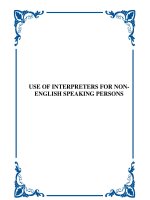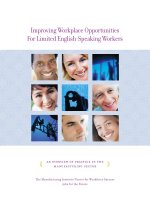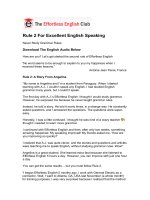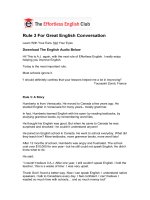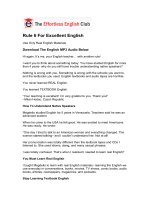Syllabus for Pilot English 6
Bạn đang xem bản rút gọn của tài liệu. Xem và tải ngay bản đầy đủ của tài liệu tại đây (234.96 KB, 19 trang )
COURSE SYLLABUS
English 6 (1 st term)
I.
•
MEETINGS:
7 lessons x 6 units + 2 lesson x 2 reviews + 3 forty-five minute tests + 3 test-correction lessons + 1 introductory
•
•
II.
•
lesson + 1 revision lesson
Three lessons a week
From Mid – August to the end of December
COURSE DESCRIPTION:
The course takes place from Mid-August to the end of December during the 1 st semester of the school year (2017-
•
2018)
The course involves in teaching English as a compulsory school subject for the sixth graders of Từ Sơn secondary
•
school.
The course is applied to the 150 sixth graders divided into 4 classes ranging from 6A1 to 6A4. Từ Sơn secondary
•
school is a high quality school with good or quite good learners from different parts of Từ Sơn Town.
The normal classrooms are one-computer rooms connected with the Internet. There is a computer lab in the school
•
where each of the classes can occupy.
The students of the school join two 45-minute weekly extra lessons in the afternoon during the 1 st semester. These
afternoon lessons focus on helping the students to consolidate the basic grammar and foster their grammatical
•
knowledge.
The course book is designed with various interesting learning activities, so the supplementary materials using such
III.
technology tools as quizlet, email, blogging are usually designed as extra home assignments
COURSE OBJECTIVES
•
The course relates to assisting the students to gain the required knowledge of grammar, lexicon, pronunciation and
word stress, and to enhance their four main communicative skills (reading, listening, writing and speaking) and soft
•
skills so that they can fulfill the requirements of a compulsory school subject.
The course is especially focused on consolidating and widening the sixth graders’ vocabulary and on developing their
•
pronunciation with some help of technology namely quizlet.
The course is especially focused on developing the students’ essay writing, listening and speaking with some help of
technology namely email and blogging.
By the end of the course, the students will be able to gain enough knowledge of grammar, vocabulary and
pronunciation to fulfill all the required tests with confidence and satisfaction.
1.Knowledge:
Grammar: Students will be able to understand and apply the given sentence structures and the tenses like Present
Simple, Present Progressive and Future Simple,…
Vocabulary: Students will have a chance to learn more words related to the topics in the course book and to use
them actively
Pronunciation: Students will get more focus on practicing the sounds like “/ʌ/, /əu/ ; /s/, /z/, /iz/ ; /b/, /p/ ;
/I/, /i:/ ; /t/, /st/ ; /s/, /ʃ/ ” and they will be given futher exercises on pronunciation and word stress
2. Skills : develop their four main skills
Reading: Students can effectively do the reading tasks in the course book and in the enclosed workbook
Listening: Students can understand what their teacher(s) and their friends say in English. They can understand the
native speaker speaking English in the videos given. Also, they can fulfill the listening tasks in the course book
Speaking: Students can express their ideas, talk about the topics in the course book and communicate with others
in the topics mentioned in the course book
Writing: Students can base on the learned structures to write correct sentences, do the writing tasks in the student’s
book and in the workbook and write passages or short essays on the themes in the course book
3. Enhance positive interaction between the teachers and the students and among the
students themselves by giving reflections on the essays that the students write in the
blog
4. Develop their soft skills for presentation, collaborative work
5. Foster their skills of working on a computer by accomplishing the supplementary
tasks in the use of quizlet, email and blogging
COURSE MATERIALS:
IV.
The materials for the course are the student’s book, the workbook and self-designed
supplementary documents. Hard copies will be distributed in some lessons. Links to the blog will be given to the
students.
V.
•
ASSESSMENT:
The copies of the rubric are weekly given to the students. Each of the student marks his/her own essays after the peer
reviews and the teacher’s comments and keep the rubrics to see their own progress.
See Rubric at link:
/>
VI.
Units
WEEKLY SCHEDULE:
Lessons
Introducti
Period
s
1
Parts
Knowledge
General introduction
Skills
General introduction
Supplementary
materials
General
Assessment
General
on
grammar/ vocabulary/
pronunciation
on
Lesson 1
2
UNIT 1
My new
school
Lesson 2
3
Lesson 3
4
Lesson 4
5
Lesson 5
6
Lesson 6
7
on skills such as reading,
speaking, listening,
writing and soft skills
Topic-introducing activities
Vocabulary: School things
Getting started
Grammar: Present simple and present progressive
Synthetic skills:
Vocabulary: Verbs
(study, have, do, play) +
A closer look 1 Nouns
Pronunciation: /
ʌ/, /əu/
Grammar: Present
A closer look 2 simple and present
progressive
Vocabulary: Extra
Interactive activities:
Communicatio
vocabulary related to
Game, interview,
n
the topic of the unit
presentation
Reading:
- Reading for specific
information about
schools
- Reading e-mails and
Skills 1:
webpages
Speaking:
- Talking about and
describing a
school/school activities
Skills 2:
Listening: Listening to
get information about
school activities/ What
students do at school
Writing:
introduction on
supplementary
materials
(Self-designed)
Technology tool:
Quizlet
LINK:
introduction
on assessment
types
- Punctuation
- Writing a webpage for
your school
Lesson 7
My home
Looking back
+ Project
Consolidation on the
learned vocabulary
and grammar
9
Lesson 2
10
Vocabulary: Houserelated words
A closer look 1
Pronunciation:/s/,/z/,
/iz/
Lesson 3
11
A closer look 2
Grammar: There
is/are… + Prep. P
12
Communicatio
n
Vocabulary: Extra
vocabulary related to
the topic of the unit
Lesson 4
Lesson 5
13
Skills 1:
Lesson 6
14
Skills 2:
Lesson 7
15
Looking back
+ Project
Project: Your dream
school
Topic-introducing activities
Vocabulary: Prepositions of place
Grammar: There is/are
Synthetic skills:
Getting
started
Lesson 1
Unit 2
8
(Self-designed)
Technology tool:
Quizlet
LINK:
Interactive activities:
gap-filling information,
presentation
Reading: Reading
emails/informal letters
about rooms in the house
Speaking: Talking
about/describing houses,
rooms and furniture
Listening: Listening to
get information about
rooms/furniture
Writing: Writing e-mails
to describe a room/house
Consolidation on the
learned vocabulary
and grammar
Project: your strange
house
Lesson 1
Lesson 2
16
17
Lesson 3
18
Lesson 4
19
Lesson 5
20
Lesson 6
21
Lesson 7
22
Unit 3
My friends
Topic-introducing activities
Vocabulary: Adjectives of personality
Getting started
Grammar: S + be + adj
Synthetic skills:
Vocabulary: Body-part
words
Pronunciation: /b/,
A closer look 1
/p/
Grammar: “have” for
descriptions
Grammar: Present
A closer look 2
progressive for future
Vocabulary: Extra
Interactive activities:
Communicatio
vocabulary related to
Discussion about features
n
the topic of the unit
of magazine pages
Reading: Reading
emails/advertisements
about things to do with
friends
Skills 1:
Speaking:
- Talking about
appearance/personality
- Talking about plans
Listening: Listening to
get information about
friends and things to do
Skills 2:
with friends
Writing: Writing to
describe friends and
things to do with friends
Consolidation on the
Looking back
Project: Your class
learned vocabulary
+ Project
yearbook
and grammar
(Self-designed)
Technology tool:
Quizlet
LINK:
Lesson 1
23
Review 1
(covering
the three
units (Unit
1, Unit 2,
Unit 3)
Lesson 2
Test
Language focus:
(from Unit 1 to Unit 3)
Pronunciation
-Vocabulary
-Grammar
-Everyday English
Reading: Reading for
choosing the best option/
answering questions
Speaking: Interviewing
Likes & dislikes about a
school
Listening: Listening to
get information
Writing: Writing an email to a friend
24
A 45-minute
test
Testcorrection
25
26
Unit 4
Lesson 1
27
My
neighborhoo
d
Lesson 2
28
Lesson 3
29
Topic-introducing activities
Getting started Vocabulary: Nouns of place
Grammar: Direction-giving expressions
Synthetic skills:
Vocabulary: Adjectives
A closer look 1 describing a place
Pronunciation: /I/, /i:/
A closer look 2 Grammar: Comparative
adjectives
(Self-designed)
Technology tool:
Quizlet
LINK:
Lesson
4
30
Communicatio
n
Lesson 5
31
Skills 1:
Lesson 6
32
Skills 2:
33
Looking back
+ Project
Lesson 7
Unit 5
Lesson 1
34
Natural
wonders of
the world
Lesson 2
35
Lesson 3
36
Vocabulary: Extra
vocabulary related to
the topic of the unit
Consolidation on the
learned vocabulary
and grammar
- Listening for fulfilling a
gap-filling exercise
- Interactive activities:
Discussion presentation
(about a guide to a place)
Reading: Reading a
description of a
neighborhood Speaking:
- Talking about and
describing a
neighborhood
- Asking for and giving
directions
Listening: Listening for
specific information to
locate places in a
neighborhood
Writing: Writing a
paragragh describing
your neighborhood
Project: your ideal
neighborhood
Topic-introducing activities
Getting started Vocabulary: Natural places
Grammar: Comparative/ superlative adjectives
Synthetic skills:
Vocabulary: Travelrelated words
A closer look 1
Pronunciation: /t/,
/st/
A closer look 2 Grammar:
- Comparative/
(Self-designed)
Technology tool:
Quizlet
LINK:
superlative adjectives
- Modal MUST (giving an
order)
Lesson
4
37
Communicatio
n
Lesson 5
38
Skills 1:
Lesson 6
39
Skills 2:
Lesson 7
40
Looking back
+ Project
Revision
41
Test
Vocabulary: Extra
vocabulary related to
the topic of the unit
Consolidation on the
learned vocabulary
and grammar
- Reading for fulfilling a
table-filling exercise
- Interactive activities:
Role-play, group work
Reading: Reading short
passages to get
information about
natural wonders
Speaking:
- Talking about and
describing things in
nature
- Giving travel advice
Listening: Listening to
get information about
amazing places or a
travel guide
Writing: Writing a travel
guide about a natural
attraction
Project: How well do you
know Viet Nam?
Grammar:
Comparison of adjectives
A 45-minute
test
Testcorrection
42
43
Lesson 1
44
(Self-designed)
Hand-out
Getting started
Topic-introducing activities
Unit 6
Vocabulary: Tet holiday-related words
Grammar: Will/should
Synthetic skills:
Our Tet
Holiday
Lesson 2
45
Vocabulary: Tet
A closer look 1 holiday-related words
Pronunciation: /s/, /ʃ/
46
A closer look 2
Grammar:
- Modals SHOULD/ WILL
Lesson
4
47
Communicatio
n
Vocabulary: Extra
vocabulary related to
the topic of the unit
Lesson 5
48
Skills 1:
Lesson 6
49
Skills 2:
Lesson 7
50
Looking back
+ Project
Lesson 3
(Self-designed)
Technology tool:
Quizlet
Consolidation on the
learned vocabulary
LINK:
- Reading for fulfilling a
matching exercise
- Interactive activities:
Game, group work
Reading: Reading about
facts of the New Year’s
practices in Viet Nam and
some other countries
Speaking:
- Talking about Tet
activities and traditions
- Giving advice: What
people should (not) do at
Tet.
Listening: Listening to
conversations about what
you should(not)do at Tet,
and about intentions
Writing: Writing a short
paragragh about what
you should(not) do at Tet
Project: I have a dream
and grammar
Lesson 1
51
Language focus:
(from Unit 4 to Unit 6)
- Pronunciation
-Vocabulary
-Grammar
-Everyday English
Review 2
(covering
the three
units (Unit
4, Unit 5,
Unit 6)
Lesson 2
Test
Reading : Reading a
website to get
information
Speaking: Pair work
Asking and answering
about which place to go
in Singapore
Listening: Listening to
get information about a
travel guide.
Writing: Writing about a
living place
52
53
1st term test
1st term test
correction
54
SUPPLEMENTARY MATERIALS
Revision – Period 41:
Grammar:
Comparison of adjectives
Hand-out
Theory:
So sánh tính từ:
Thể loại
Tính từ ngắn
Tính từ dài
so sánh
1. So sánh
không bằng
2. So sánh
bằng
3. So sánh
kém hơn
4. So sánh
hơn
He is kind
He is intelligent
He is not so kind as she is.
He is not so intelligent as she is.
*S+ (be) not + as/so+ ADJ+ as + S’…
*S+ (be) not + as/so+ ADJ+ as + S’…
He is as kind as she is.
He is as intelligent as she is.
*S+ (be) + as+ ADJ+ as + S’…
*S+ (be) + as+ ADJ+ as + S’…
He is less kind than she is.
He is less intelligent than she is.
*S+ (be) + less+ ADJ+ than+S’…
*S+ (be) + less+ ADJ+ than+S’…
He is kinder than she is.
He is more intelligent than she is.
*S+ (be) + (ADJ+er)+ than+S’…
*S+ (be) + (more+ADJ)+ than+S’…
5. So sánh
kém nhất
6. So sánh
nhất
He is the least kind (person) of all.
He is the least intelligent (person) of all.
*S+(be) + the least (ADJ)+{N}+in/of/…
*S+(be) + the least (ADJ)+{N}+in/of/…
He is the kindest (person) of all.
He is the most intelligent (person) of all.
*S+(be) + the(ADJ+est)+{N}+in/of/…
*S+(be) + the (most+ADJ)+{N}+in/of/…
1. Quy luật thêm “-er”, “-est” vào sau tính từ ngắn.
- Thông thường ta thêm “-er” / “-est” vào ngay sau tính từ ta cần biến đổi.
e.g: long (dài)
- longer (dài hơn)
- the longest (dài nhất)
short (ngắn) - shorter (ngắn hơn) - the shortest (ngắn nhất)
- Nếu tính từ tận cùng đã có sẳn “-e”, thì chỉ thêm “-r”, và “-st”.
e.g: large (rộng) - larger (rộng hơn) - the largest (rộng nhất)
- Nếu tính từ tận cùng là một nguyên âm + một phụ âm, thì ta gấp đôi phụ âm cuối khi thêm “-er”, “-est”.
e.g: big (lớn) - bigger (lớn hơn) - the biggest (lớn nhất)
- Nếu tính từ tận cùng là một phụ âm + “-y”, ta đổi “-y” thành “-i” rồi thêm “-er”, “-est”.
e.g: dry (khô ráo) - drier (khô hơn) - the driest (khô nhất)
•
Quy tắc thêm “-er”, “-est” vào trạng từ ngắn khi đổi sang so sánh hơn và so sánh nhất cũng giống như trên.
2. Tính từ 2 âm tiết, tận cùng là: “-y”, “-ow”, “-er”, “-tle”, “-ple”, thuộc nhóm tính từ ngắn.
3. Động từ ở Quá khứ phân từ (V3) thuộc nhóm tính từ dài.
4. Vị trí thành phần bổ nghĩa nhấn mạnh trong so sánh tính từ: “…as much frightened as…”
Để nhấn mạnh so sánh, có thể thêm much / far / a lot trước so sánh hơn, công thức:
S + (V) + far/much + Adj/Adv-er + than + noun/pronoun
S + (V) + far/much + more + Adj/Adv(dài) + than + noun/pronoun
•
•
Harry’s watch is far more expensive than mine.
He speaks English much more rapidly than she does .
Để nhấn mạnh so sánh, có thể thêm VERY/TOO MUCH trước so sánh hơn
- He is very much taller than his brother (positive idea)
- This is too much more expensive, I can't buy it (negative idea)
Để giảm độ mạnh so sánh, có thể thêm a little / a bit / slightly trước so sánh hơn, công thức:
S + (V) + a little / a bit + Adj/Adv-er + than + noun/pronoun
S + (V) + a little / a bit + more + Adj/Adv(dài) + than + noun/pronoun
•
Harry’s watch is a bit more expensive than mine.
5. Tính từ ghép: “hard-working” → harder-working → the hardest-working
6. Các tính từ bất qui tắc:
Good
→ better
→ (the) best
tốt, giỏi
Well
→ better
→ (the) best
khỏe mạnh
Bad
→ worse
→ (the) worst
xấu, tệ
Many
→ more
→ (the) most
nhiều
Much
→ more
→ (the) most
nhiều
Little
→ less
→ (the) least
ít
Near
→ nearer
→ (the) nearest
gần
Far
→ farther
→ (the) farthest
xa
→ further
→ (the) furthest
(nghĩa bóng)
→ (the) next
kế bên cạnh
Lưu ý: farther : dùng cho khoảng cách / further : dùng cho thông tin hoặc một số trường hợp trừu tượng khác
•
•
•
Late
Old
The distance from your house to school is farther than that of mine.
If you want more/further information, please call to the agent.
Next year he will come to the U.S for his further (= more) education
→ later
→ (the) latest
trễ
→ latter
→ older
→ (the) oldest
cũ, già
→ elder
→ (the) eldest
cả, trưởng
In → inner → (the) innermost
bên trong
Out → outer → (the) outmost
bên ngoài
Up
→ (the) last
→ upper
sau cùng
→ (the) uppermost
bên trên
7. Khi dùng so sánh nhất cho hai đối tượng, ta đặt “the” trước tính từ ở thể so sánh hơn.
•
Khi so sánh giữa 2 người hoặc 2 vật, chỉ được dùng so sánh hơn kém, không được dùng so sánh bậc nhất, mặc dù trong một
số dạng văn nói và cả văn viết vẫn chấp nhận so sánh bậc nhất.
• Trước adj và adv so sánh phải có the, trong câu có thành ngữ of the two + noun thành ngữ có thể đứng đầu hoặc cuối câu
VD: Of the two shirts, this one is the prettier.
She is the more beautiful girl of the two sisters. Cô ấy là cô gái xinh đẹp nhất trong số 2 chị em.
8. Khi dùng so sánh nhất cho ba đối tượng trở lên, ta áp dụng theo quy tắc trong bảng so sánh tính từ ở phần trên.
VD: She is the most beautiful girl of the three sisters. Cô ấy là cô gái xinh đẹp nhất trong số 3 chị em.
9. Khi so sánh một người/ một vật với tất cả những người hoặc vật khác phải thêm else sau anything/anybody...
Ex: He is smarter than anybody else in the class.
10. * Dùng thêm that of cho danh từ số ít:
Incorrect: The salary of a professor is higher than a secretary. (Câu này so sánh salary với secretary)
Correct: The salary of a professor is higher than that of a secretary. (that of = the salary of)
* Dùng thêm those of cho các danh từ số nhiều:
Incorrect: The duties of a policeman are more dangerous than a teacher . (Câu này so sánh duties với teacher)
Correct:
Theduties of a policeman are more dangerous than those of a teacher . (those of = the duties of)
Practice:
COMPARISON
I. Choose the correct answer
1. Of the four dresses, I like the red one (better/best).
2. Pat’s car is (faster/fastest) than Dan’s.
3. John is (less/least) athletic of all the men.
4. Does Fred feel (weller/better) today than he did yesterday?
5. My cat is the (prettier/prettiest) of the two.
6. This vegetable soup tastes very (good/best).
7. David is the (happier/happiest) person that we know.
8. This summery is (the better/the best) of the pair.
9. Jim has as (few/fewer) opportunities to play tennis as I do.
10. The museum is (the further/the furthest) away of the three buildings.
II. Complete the following sentences with the appropriate form of the words in brackets.
1. Learning to speak a language is often much (easy) _____________________ than learning to write it.
2. This hotel must be (expensive)____________________ than the small one next door.
3. He is certainly (unusual)___________________person I have ever met.
4. His latest film is (interesting)_____________________ than his previous ones.
5. What is (difficult)_______________________ thing you have ever done?
6. Losing your credit card is (bad)_______________________ than losing your money.
7. Bringing up children is one of (hard)_____________________ jobs in the world.
8. When I saw her, she looked much (thin)______________________ than I remembered her.
III. Complete the sentences below, using the suitable comparison form of the adjectives from the box. One of
these adjectives is used twice.
warm
lucky
comfortable
cheap
simple
intelligent
boring
hot
difficult
1. This exercise is too easy – can’t we try a ____________________ one?
2. England is too cold in spring – let’s go to Spain where is ____________________.
3. She comes top in all exams – she must be _________________________ girl in the class.
4. The temperature in July reaches forty – four degrees – it’s ______________________ month of the year.
5. Let’s buy this video – it doesn’t cost too much – it’s ______________________ the other one.
6. When I passed my driving test, it was the _________________________ day of my life.
7. Lying down in bed is ___________________________ sitting on a hard chair.
8. I could hardly keep awake – it was _______________________________ film I’ve ever seen.
9. She’s ______________________________ person I know – she is always winning prizes in lotteries.
10. I can’t do this test – can you give me a ______________________________ one?
IV. Rewrite the sentences, beginning as shown.
1. Yesterday the temperature was nine degrees, but today it is only six degrees.
It’s................................................................................................................................................................................
2. Tom is the best football player in this team. Tom is a better …………………………anyone else …………………
3. Nothing is faster than the speed of light. The speed of light.........................................................
4. Jack is younger than he looks. Jack isn’t.................................................................................................
5. I have never met anyone as interesting as he is. He is ....................................................................




